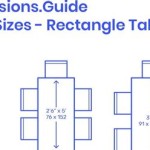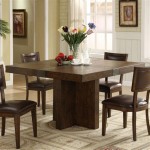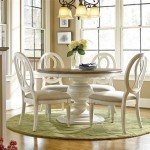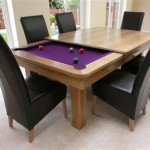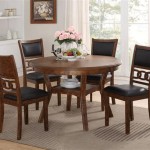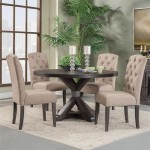Round Dining Table vs. Rectangle: A Comparative Analysis
The selection of a dining table is a significant decision in interior design, impacting both the functionality and aesthetic appeal of the dining space. Among the various shapes available, round and rectangular dining tables are the most prevalent choices, each possessing distinct characteristics that cater to different needs and preferences. This article provides a detailed comparison of round and rectangular dining tables, exploring their advantages and disadvantages across several key aspects to assist in making an informed decision.
The choice between a round and a rectangular dining table is rarely arbitrary. It often hinges on factors such as the room's dimensions, the number of people regularly dining, the desired ambiance, and the overall design scheme of the home. Understanding the specific nuances of each shape is crucial for selecting the table that best complements the existing environment and fulfills the intended purpose.
Space Efficiency and Room Shape Compatibility
One of the primary considerations when choosing a dining table is its interaction with the available space. Round tables are generally considered more space-efficient in smaller rooms or square-shaped rooms. Their circular form allows for easier movement around the table, as there are no sharp corners to navigate. This fluidity can make a smaller dining area feel less cramped and more open.
The absence of corners also means that round tables require less clearance space than rectangular tables. Individuals can more easily squeeze past seated diners without bumping into the table's edge. This is particularly beneficial in apartments or homes where space is at a premium.
Rectangular tables, conversely, are better suited for larger, rectangular rooms. Their elongated shape mirrors the room's geometry, creating a sense of visual harmony. Placing a rectangular table in a square room can sometimes make the space feel unbalanced or disproportionate. However, in a long, narrow dining room, a rectangular table is often the most logical choice, maximizing seating capacity along its length.
The footprint of each table shape also plays a role. A large round table, while aesthetically pleasing, can occupy a considerable amount of floor space, potentially overwhelming a small room. Similarly, a very narrow rectangular table might appear insignificant in a large, open-plan dining area.
Seating Capacity and Social Interaction
The shape of a dining table significantly influences seating capacity and the dynamics of social interaction during meals. Rectangular tables generally provide a greater seating capacity compared to round tables of similar surface area. This is because the elongated shape allows for more chairs to be placed along the table's sides. For large families or individuals who frequently host dinner parties, a rectangular table is often the more practical option.
Round tables, on the other hand, foster a sense of intimacy and equality among diners. Because everyone is equidistant from the center of the table, it encourages conversation and interaction. There is no head of the table, which can create a more relaxed and informal atmosphere. This makes round tables ideal for smaller gatherings where fostering a sense of connection is paramount.
The ease of conversation is another advantage of round tables. Diners can easily see and speak with everyone else at the table, facilitating a more inclusive and engaging dining experience. With rectangular tables, conversation can be more challenging, particularly for individuals seated at opposite ends of the table.
However, it is important to consider the size of the round table when evaluating seating capacity. A small round table might only comfortably accommodate four people, while a large round table could seat up to eight. The diameter of the table directly impacts the number of chairs that can be placed around it without crowding the space.
Style and Aesthetic Considerations
The shape of a dining table contributes significantly to the overall style and aesthetic of the dining room. Round tables often exude a sense of elegance and sophistication, particularly when paired with a pedestal base. They can create a softer, more inviting atmosphere, making them well-suited for traditional or transitional design schemes.
Rectangular tables, in contrast, tend to project a more formal and structured appearance. Their clean lines and geometric shape lend themselves well to modern and contemporary interiors. A rectangular table can also serve as a focal point in a dining room, particularly when made from a striking material or featuring a unique design.
The choice of table shape can also influence the selection of other dining room furniture. For example, a round table might be complemented by curved-back chairs and a round chandelier, while a rectangular table might pair well with straight-lined chairs and a rectangular pendant light.
Ultimately, the aesthetic appeal of a dining table is subjective and depends on personal preference. However, considering the overall design style of the home and the desired ambiance of the dining room is essential when making a decision. A well-chosen dining table can enhance the visual appeal of the space and create a welcoming environment for meals and gatherings.
Versatility and Adaptability
The versatility of a dining table refers to its ability to adapt to different needs and situations. Rectangular tables are generally more versatile in terms of accommodating varying numbers of guests. Additional chairs can easily be added to the ends of the table when needed, providing extra seating capacity. Extendable rectangular tables offer even greater flexibility, allowing the table's length to be adjusted to suit the number of diners.
Round tables lack this inherent adaptability. Adding extra chairs around a round table can quickly lead to overcrowding and discomfort. While some round tables feature drop-leaf extensions, these are less common and often provide a less significant increase in seating capacity compared to extendable rectangular tables.
The configuration of the dining room is another factor to consider. Rectangular tables can be easily positioned against a wall or in a corner to maximize space when not in use. Round tables, however, require more clearance space around them and are typically placed in the center of the room to maintain a balanced aesthetic.
The functional uses of the dining table beyond dining also impact its versatility. Rectangular tables provide a larger, more stable surface for activities such as working from home, playing board games, or crafting. Round tables, while suitable for some of these activities, may feel less practical due to their limited surface area and lack of corners.
Material and Construction Considerations
The material and construction of a dining table are crucial factors that influence its durability, longevity, and aesthetic appeal, regardless of its shape. Both round and rectangular tables are available in a wide range of materials, including wood, metal, glass, and stone. The choice of material should be based on factors such as the desired style, budget, and maintenance requirements.
Wooden dining tables are a popular choice for both round and rectangular shapes due to their natural warmth and versatility. Solid wood tables are particularly durable and can last for generations with proper care. However, they can also be more expensive than tables made from other materials. Wood veneer tables offer a more affordable alternative, but they are less resistant to scratches and dents.
Metal dining tables are often chosen for modern and industrial-style interiors. They are typically durable and easy to clean, but they can also feel cold and impersonal. Glass dining tables create a light and airy feel in a dining room, but they require frequent cleaning to maintain their pristine appearance. Stone dining tables, such as marble or granite, are highly durable and luxurious, but they are also very heavy and expensive.
The construction of the table's base is another important consideration. Round tables often feature a pedestal base, which provides stability and allows for more legroom. Rectangular tables typically have four legs, which can be positioned at the corners of the table or along the sides. The placement of the legs can impact seating capacity and comfort.
When evaluating the construction quality of a dining table, it is important to inspect the joints, hardware, and finish. A well-constructed table will be sturdy and stable, with no wobbling or loose connections. The finish should be smooth and even, protecting the table from scratches and stains.

Round Vs Rectangular Dining Tables Which Is Better For You Frwd By Cuura Space

Round Vs Rectangular Dining Table Maid2match
Round Vs Rectangular Dining Tables Which Is Better For You Frwd By Cuura Space

Rectangle Vs Round Dining Tables Living With Style

Round Or Rectangle Dining Table Yay Nay

Round Vs Rectangle Dining Table

Dining Table Shapes Which Is Best For You Cabinfield Blog

Round Vs Rectangular Dining Tables Which One Fits Your Space Best Horegener

Round Table Vs Rectangular Which Dining Is Right For You East West Furniture Direct

Round Vs Rectangular Dining Tables Choose The Best For Your Space

